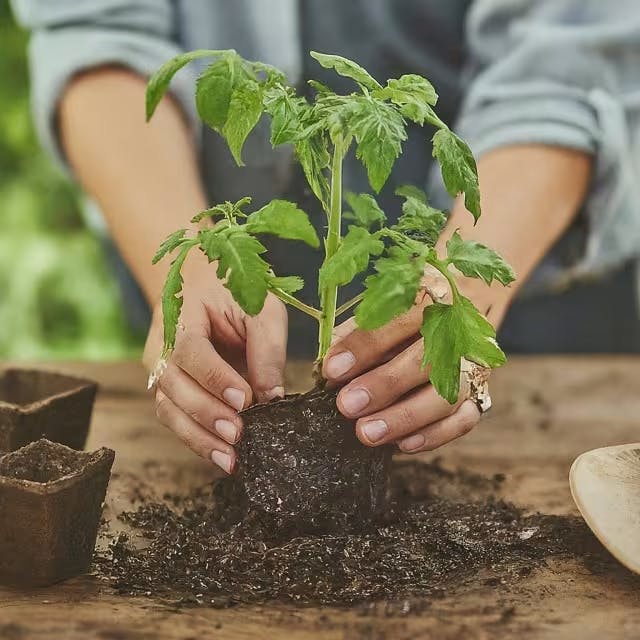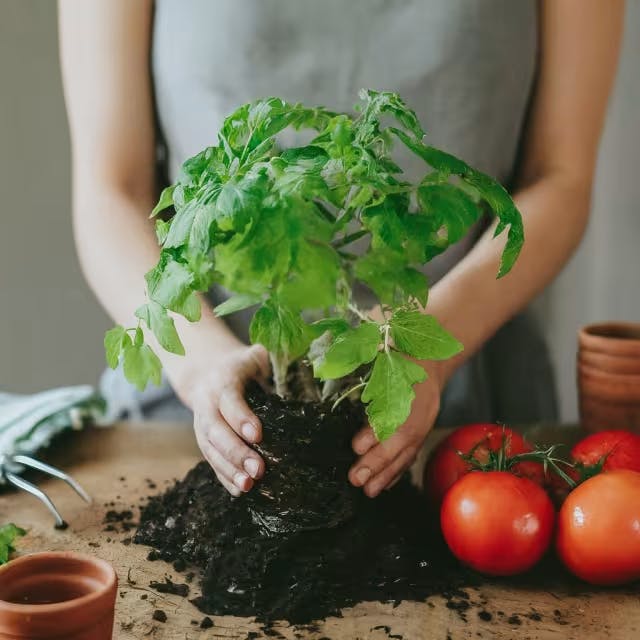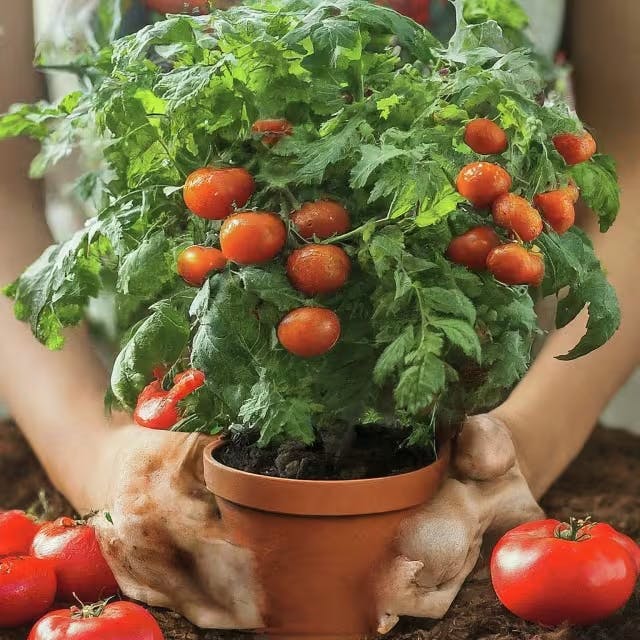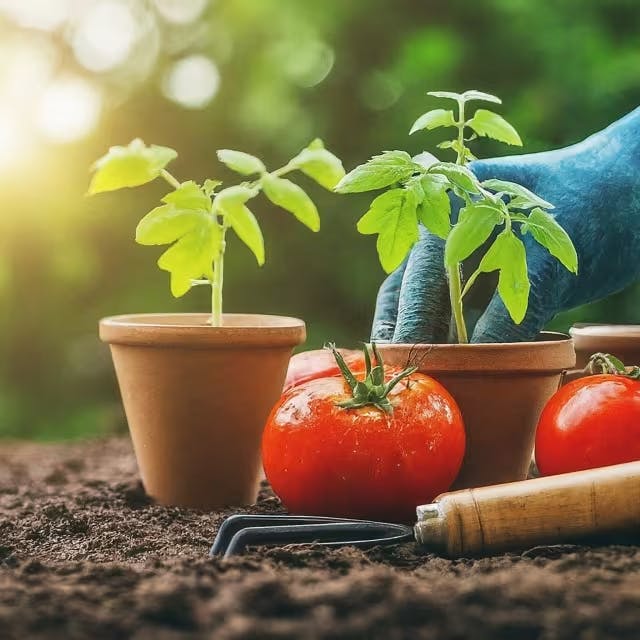Repotting Tomato Seedlings for Stronger Plants
Go4Turf
February 19, 2024

As your tomato seeds begin their journey to becoming lush, fruitful plants, understanding the nuanced steps of repotting tomato seedlings for stronger plants becomes crucial. From the initial excitement of witnessing all your tomato seeds germinate to the pivotal moment of transplanting them to bigger pots for optimal growth, every step is a building block towards a thriving garden. This guide will navigate you through the essential stages—from determining the right time and pot for repotting, to a step-by-step process ensuring your tomato plants develop formidable root systems, readying them for their final destination in your garden.
Key Takeaways
Repotting tomato seedlings is a critical step for developing a stronger, more resilient root system.
Knowing when to repot—a combination of seedling size and timing—ensures optimal growth and health.
Choosing the right pot size and type affects the development and future transplanting success of tomato plants.
A step-by-step approach to repotting helps prevent damage to the young plants and promotes better establishment.
Repotting benefits include accelerated growth, improved nutrient uptake, and increased resistance to diseases and pests.
Proper repotting practices set the foundation for a thriving and productive garden, leading to a bountiful tomato harvest.

Understanding the Basics of Repotting Tomato Seedlings
To ensure your tomato seedlings develop into strong, healthy plants, repotting them is a crucial step. This process encourages a robust root system, vital for nutrient uptake and overall growth. When a seedling outgrows its initial container, its roots can become bound and growth may be stunted. By transferring your plants to larger pots, you give their roots room to expand.
Before repotting, make sure you have the right supplies. You'll need a larger pot, high-quality potting mix, and a small trowel. For a sustainable gardening approach, consider creating your own DIY seed starting and potting mix. This mixture can provide your tomatoes with the perfect balance of nutrients, drainage, and moisture retention.
When choosing the timing, repot after the seedlings have developed their second set of true leaves but before they become root-bound. Gently loosen the roots during the transfer to encourage them to spread out in their new pot.
Watering immediately after repotting helps reduce transplant shock and settles the soil. Continuing care involves monitoring water, sunlight, and nutrient needs. For additional tips on ensuring your tomato plants thrive, explore insights on mastering garden health and growth.
Repotting your tomato seedlings is more than just a step in the gardening process; it's an investment in their future growth and productivity. With the right care, these seedlings will grow into strong plants capable of producing an abundant harvest.

Choosing the Right Time and Pot for Repotting Tomato Plants
Knowing when to move your tomato seedlings to a larger pot is crucial for their growth and vitality. A good rule of thumb is to repot when they've developed their first true set of leaves or when you notice roots peeking out of the current container’s drainage holes. This stage indicates that the seedlings require more space to spread their roots and access nutrients effectively.
For the pot selection, opt for a container that is at least 12 inches deep. This size allows ample room for root growth, crucial for tomato plants to absorb moisture and nutrients. When selecting pots, the material also matters. Fabric pots provide excellent aeration and prevent overwatering, while traditional plastic or terra cotta pots are durable and retain moisture well.
A quality potting mix is essential for repotting success. A mix designed for tomatoes or vegetables ensures the right nutrient balance and supports healthy growth. For those interested in creating their own mix, a combination of peat moss, vermiculite, and compost can be a good start. DIY enthusiasts can find tips and a guide on creating an effective seed starting and potting mix which emphasizes the importance of drainage and nutrient retention.
While repotting, remember to gently tease the roots to encourage them to spread out in their new home. This practice helps establish a robust root system, essential for absorbing water and nutrients. Providing a stake or support at the time of repotting can also prevent damage as the plant grows.
Lastly, secure your investment in healthier tomato plants by learning efficient tomato growing tips, which include selecting the correct pot size, ensuring adequate sunlight, and the importance of grouping pots for optimal growth conditions. This holistic approach to repotting tomato seedlings sets the stage for a bountiful and delicious harvest.
Step-by-Step Guide to Repotting Tomato Seedlings for Optimal Growth
When it comes to nurturing your tomato seedlings into robust, fruit-bearing plants, repotting plays a pivotal role. Here's a brief, easy-to-follow guide to ensure you're equipped for success.
Choose the Right Pot: Opt for a container that is at least 3 inches larger in diameter than the current one. This provides ample room for growth.
Prepare Your Potting Mix: A rich, nutritious potting mix is vital for healthy root development. You can create your own or opt for a high-quality pre-made mix. Ensure it's well-draining to prevent waterlogging.
Repotting Process: Gently remove the tomato seedling from its current container, taking care not to damage the roots. Fill the new pot with a layer of potting mix, place the seedling inside, and then cover the roots with more mix. Press lightly to secure the plant.
Watering After Repotting: After repotting, water the seedling thoroughly. This helps settle the soil and eliminates air pockets. Continue to monitor soil moisture and water as needed to keep it consistently moist.
Location Matters: Place your repotted tomato seedling in a spot that receives plenty of sunlight. Tomatoes thrive with around 6 to 8 hours of direct sunlight each day.
Successfully repotting your tomato seedlings not only encourages a stronger root system but also significantly impacts their overall health and productivity. By following these steps, along with incorporating continuous-release fertilizer, you're setting the stage for a bountiful tomato harvest.

The Benefits of Repotting Tomato Seedlings for a Thriving Garden
Repotting tomato seedlings is a crucial step for any gardener aiming for a luscious and healthy harvest. As seedlings grow, their initial containers can hinder their development, leading to cramped roots and stunted growth. Repotting encourages a robust root system, essential for nutrient uptake and overall plant health.
When you repot, you provide your tomato seedlings with more space to expand their roots. This not only strengthens the plant's foundation but also enhances its ability to absorb water and nutrients, key components for vigorous growth. For those eager to dive deeper into plant nurturing, discovering how to create a DIY seed starting and potting mix can be incredibly beneficial. An optimal mix promotes healthy root growth and ensures your tomatoes have everything they need to thrive.
Moreover, learning the perfect timing for repotting is paramount. Too early, and the seedlings may not have developed enough to handle the move; too late, and the plant could already be experiencing stress from being root-bound. Pairing repotting with essential gardening tips from sources like "Transform Your Black Thumb into a Green Thumb: Essential Tips" ensures your tomatoes get the best start.
In essence, repotting tomato seedlings isn't just about moving plants into a new home. It's about giving them the environment they need for successful growth. Alongside proper sunlight, water, and nutrients, a well-timed relocation sets the stage for a garden filled with vibrant tomatoes. In conclusion, repotting tomato seedlings is a critical step towards nurturing stronger plants that will yield an impressive harvest. By understanding the importance of selecting the right moment and container for repotting, along with following a comprehensive guide to ensure the process contributes to optimal growth, gardeners can significantly enhance the health and productivity of their tomato plants. This practice is indispensable for anyone looking to maximize the potential of their tomato garden, fostering plants that are resilient, vibrant, and fruitful.
Frequently Asked Questions
Why is repotting tomato seedlings crucial for their growth and vitality?
Repotting tomato seedlings is essential to ensure their growth and vitality. This process provides the plants with more space for root expansion, crucial for absorbing nutrients and water efficiently. By moving the seedlings to larger pots, you prevent the roots from becoming bound and stunted. Additionally, a well-timed repot allows the development of a stronger root system, which is fundamental for the plant's overall health and productivity.
How do you choose the right pot and potting mix for repotting tomato seedlings?
Choose a pot at least 3 inches larger in diameter than the current one for ample growth space. Use a high-quality potting mix or create your own for proper nutrition and drainage. Gently transplant, ensuring roots are covered but not compacted. Water thoroughly after repotting and place in a sunny location, ensuring at least 6 to 8 hours of direct sunlight daily. This encourages strong root development and overall plant health, setting the stage for a robust tomato harvest.
What is the optimal timing for repotting tomato seedlings to encourage strong root development?
The optimal timing for repotting tomato seedlings is after they have developed their second set of true leaves but before they become root-bound. This stage is crucial as it allows the seedlings to develop a strong root system in a new, larger container, which is vital for their growth and health. Gently loosening the roots during repotting encourages them to spread out in their new pot, enhancing their ability to absorb nutrients and water.
How can gently teasing the roots during repotting benefit tomato seedling growth?
Gently teasing the roots during repotting is beneficial for tomato seedlings as it encourages them to spread out in their new, larger pot. This action helps establish a more robust root system, crucial for improved water and nutrient absorption. Ultimately, this leads to stronger, healthier tomato plants capable of producing a bountiful harvest.
What continued care should be provided to tomato seedlings after repotting to ensure robust plant health?
After repotting tomato seedlings, ensure their robust growth by providing adequate sunlight, about 6 to 8 hours daily. Monitor soil moisture closely, keeping it consistently moist, but avoid waterlogging. Consider using a continuous-release fertilizer to supply essential nutrients over time. Regularly check for pests or diseases and address them promptly to maintain plant health.